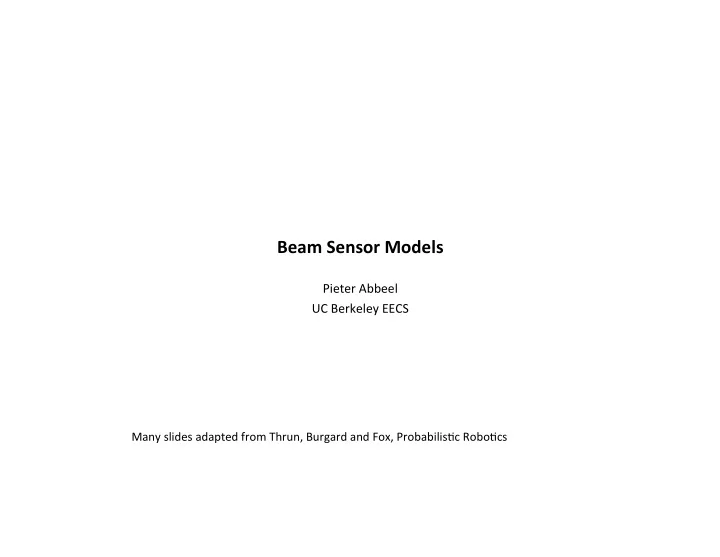

Beam Sensor Models Pieter Abbeel UC Berkeley EECS Many slides adapted from Thrun, Burgard and Fox, ProbabilisAc RoboAcs
Proximity Sensors The central task is to determine P(z|x) , i.e., the probability of a measurement z n given that the robot is at posiAon x . Ques0on : Where do the probabiliAes come from? n Approach : Let ’ s try to explain a measurement. n
Beam-based Sensor Model n Scan z consists of K measurements. z = { z , z ,..., z } 1 2 K n Individual measurements are independent given the robot posiAon. K P ( z | x , m ) P ( z | x , m ) ∏ = k k 1 =
Beam-based Sensor Model K P ( z | x , m ) P ( z | x , m ) ∏ = k k 1 =
Typical Measurement Errors in Range Measurements 1. Beams reflected by obstacles 2. Beams reflected by persons / caused by crosstalk 3. Random measurements 4. Maximum range measurements
Beam-based Proximity Model Measurement noise Unexpected obstacles 0 z exp z max z exp 0 z max 2 z e z z ( z z exp ) − λ 1 − ⎧ ⎫ η λ < 1 − exp P ( z | x , m ) = P ( z | x , m ) e 2 b ⎨ ⎬ = η unexp hit 0 otherwise 2 b π ⎩ ⎭
Beam-based Proximity Model Random measurement Max range z exp z exp 0 z max 0 z max 1 1 P ( z | x , m ) P ( z | x , m ) = η = η max rand z z small max
ResulAng Mixture Density T P ( z | x , m ) α ⎛ ⎞ ⎛ ⎞ hit hit ⎜ ⎟ ⎜ ⎟ P ( z | x , m ) α ⎜ ⎟ ⎜ ⎟ unexp unexp P ( z | x , m ) = ⋅ ⎜ ⎟ ⎜ ⎟ P ( z | x , m ) α max max ⎜ ⎟ ⎜ ⎟ ⎜ ⎟ ⎜ ⎟ P ( z | x , m ) α ⎝ ⎠ ⎝ ⎠ rand rand How can we determine the model parameters?
Raw Sensor Data Measured distances for expected distance of 300 cm. Sonar Laser
ApproximaAon P ( z | z ) n Maximize log likelihood of the data exp n Search space of n-1 parameters. n Hill climbing n Gradient descent n GeneAc algorithms n … n DeterminisAcally compute the n-th parameter to saAsfy normalizaAon constraint.
ApproximaAon Results Laser 300cm 400cm Sonar
ApproximaAon Results Laser Sonar
Influence of Angle to Obstacle "sonar-0" 0.25 0.2 0.15 0.1 0.05 0 70 0 10203040506070 0 10 20 30 40 50 60
Influence of Angle to Obstacle "sonar-1" 0.3 0.25 0.2 0.15 0.1 0.05 0 70 0 10203040506070 0 10 20 30 40 50 60
Influence of Angle to Obstacle "sonar-2" 0.3 0.25 0.2 0.15 0.1 0.05 0 70 0 10203040506070 0 10 20 30 40 50 60
Influence of Angle to Obstacle "sonar-3" 0.25 0.2 0.15 0.1 0.05 0 70 0 10203040506070 0 10 20 30 40 50 60
Summary Beam-based Model Assumes independence between beams. n JusAficaAon? n Overconfident! n Models physical causes for measurements. n Mixture of densiAes for these causes. n Assumes independence between causes. Problem? n ImplementaAon n Learn parameters based on real data. n Different models should be learned for different angles at which the sensor beam hits the obstacle. n Determine expected distances by ray-tracing. n Expected distances can be pre-processed. n
Recommend
More recommend